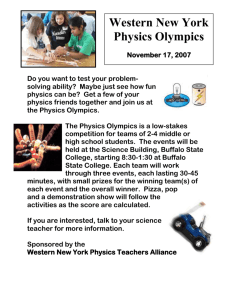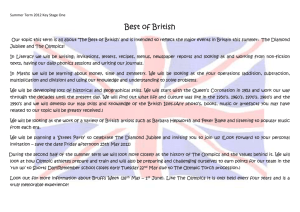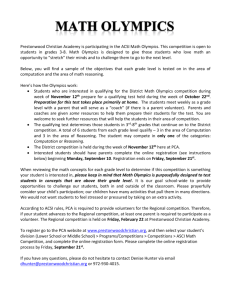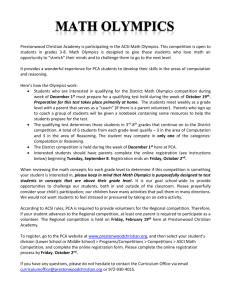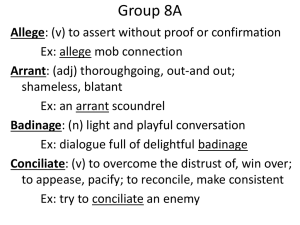Representing Juggernaut for Recognition by SNePS CVA Noun
advertisement
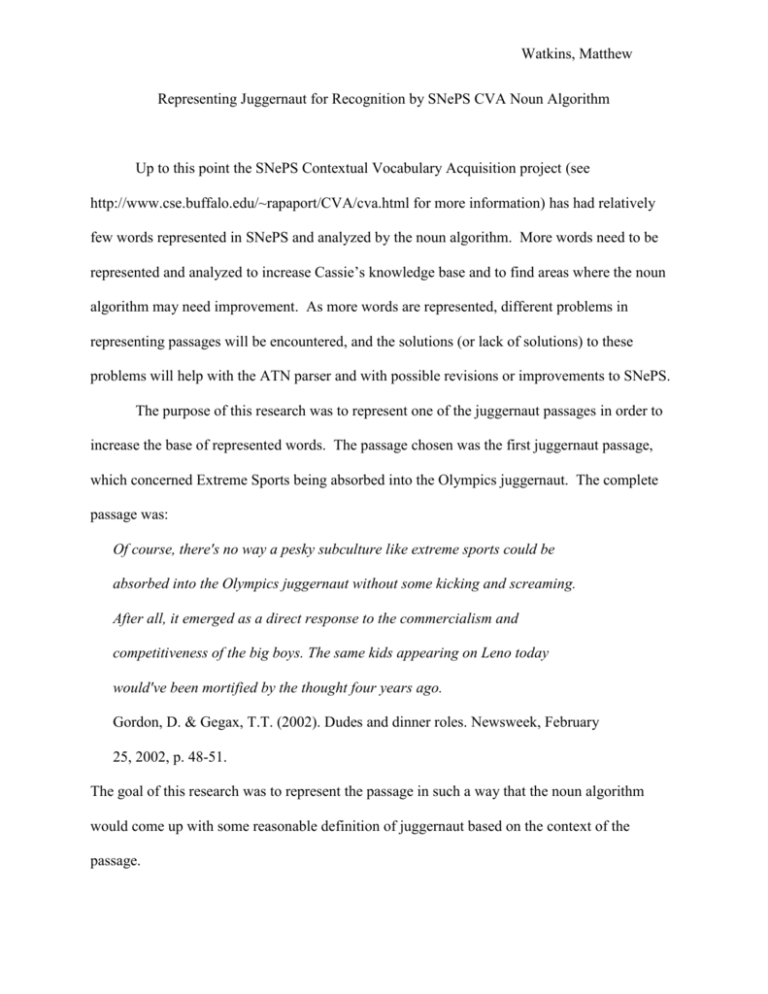
Watkins, Matthew Representing Juggernaut for Recognition by SNePS CVA Noun Algorithm Up to this point the SNePS Contextual Vocabulary Acquisition project (see http://www.cse.buffalo.edu/~rapaport/CVA/cva.html for more information) has had relatively few words represented in SNePS and analyzed by the noun algorithm. More words need to be represented and analyzed to increase Cassie’s knowledge base and to find areas where the noun algorithm may need improvement. As more words are represented, different problems in representing passages will be encountered, and the solutions (or lack of solutions) to these problems will help with the ATN parser and with possible revisions or improvements to SNePS. The purpose of this research was to represent one of the juggernaut passages in order to increase the base of represented words. The passage chosen was the first juggernaut passage, which concerned Extreme Sports being absorbed into the Olympics juggernaut. The complete passage was: Of course, there's no way a pesky subculture like extreme sports could be absorbed into the Olympics juggernaut without some kicking and screaming. After all, it emerged as a direct response to the commercialism and competitiveness of the big boys. The same kids appearing on Leno today would've been mortified by the thought four years ago. Gordon, D. & Gegax, T.T. (2002). Dudes and dinner roles. Newsweek, February 25, 2002, p. 48-51. The goal of this research was to represent the passage in such a way that the noun algorithm would come up with some reasonable definition of juggernaut based on the context of the passage. Watkins, Matthew There are two think-aloud protocols for the above passage. The people in the protocols arrived at two different meanings for juggernaut. One protocol said that juggernaut is an establishment or institution. The other said that juggernaut is related to culture or is some sort of cultural object. In comparison, the actual definition of juggernaut, according to the dictionary, is “a force that is relentlessly destructive, crushing, and insensitive” (“Juggernaut”). Of the initial passage only the first sentence was represented. This sentence was broken down into four segments to represent. First, Extreme Sports is a pesky subculture. Second, Extreme Sports is absorbed into the Olympics juggernaut. Third, some people kick and scream. Finally, if Extreme Sports is absorbed into the Olympics juggernaut then some people will kick and scream. Watkins, Matthew Background information was included for all important concepts. Extreme sports was represented as a subclass of sports and had the property of being extreme. Extreme and normal were said to be antonyms. To make the antonym case frame useful a rule was created that said if x and y are antonyms and z has the property x, then z does not have the property y. A rule was also needed to say that if x and y are antonyms and z does not have the property x, then z does have the property y. Watkins, Matthew The background for subculture said that it was a subclass of culture and was “outside of” established culture, which was also a subclass of culture. Established culture also had the property of being normal. Olympics was a member of established culture, of institution, and of sports events. Watkins, Matthew The other interesting background information included was a rule for absorbed into. It said that if x is absorbed into y at time t, then there is some time t′ preceding t, such that x is not part of y at time t′ and that x is part of y at time t. The temporal information for this rule was probably not necessary at this time for the current goal of the representation, but may be useful as time is incorporated into the noun algorithm and other passages. Other background information was included, but it was relatively unimportant to the goal of deriving a definition for juggernaut. When the algorithm was run it came up with the following definition for juggernaut. Possible Properties: absorbed into subculture Watkins, Matthew This appears to say that juggernaut is possibly absorbed into subculture; however, this is likely an anomaly in the noun algorithm and the definition is really saying that subculture is possibly absorbed into juggernaut. This definition is not the most ideal definition hoped for based on the passage, but it does to some degree show the fact that the Olympics is some sort of cultural object and that a subculture, namely Extreme sports, is absorbed into it. In an attempt to improve this definition, the original representation was slightly modified and one major additional rule was added. The changes involved switching some of the memberclass case frames used for Olympics to subclass-superclass case frames. Specifically, Olympics was made a subclass of established culture and a subclass of institution. This replaced the member-class relationship that was originally used to relate these words. A rule was added that said, for all x and z, if x has the property of “Olympics” and “Olympics” is a subclass of some z, then presumably x is a subclass of z. Watkins, Matthew After these changes were made the algorithm game up with the following definition for juggernaut: Definition of juggernaut: Class Inclusions: institution, established culture Possible Properties: absorbed into subculture Possibly Similar Items: Olympics This definition is very similar to that from the think aloud protocols. The class inclusions for juggernaut of institution and established culture largely sum up the two definitions given in the think aloud protocols saying juggernaut is either an establishment or some part of culture. The Watkins, Matthew definition also shows that Olympics is similar to juggernaut, which in this passage is correct as the two are used to represent the same thing, the Olympics juggernaut, which operates as a single object in the passage (although not in the SNePS representation). This second representation has the advantage of providing a more complete and more satisfactory definition for juggernaut. It does have a few drawbacks. For one, the rule concerning Olympics being a property of some object x and x then being a subclass of z might not always be true. If, for example, Olympics was represented as a subclass of sports events as opposed to the member-class relationship which was used then juggernaut would have a class inclusion of sports event, which in general is not true. Another con of the second representation is that certain relationships concerning Olympics were done as subclass-superclass as opposed to member-class which might have been more appropriate. Representing Olympics as a subclass of established culture is one instance where member-class may have been more appropriate (but would not have produced the desired definition in the end). Future work should involve representing more of the juggernaut passages to see if Cassie can come up with a more precise definition of juggernaut. Additional passages may help make the definition more general and less particular to the singular case of Olympics juggernaut. In the process of representing this passage the general problem of how to represent a noun-noun object arose. A noun-noun object, such as Olympics juggernaut, uses a noun as an adjective (Olympics) to modify another noun (juggernaut). The simple solution to representing this is to use the mod-head case frame; the noun algorithm, however, does not recognize this case frame when one of the words in the case frame is the word to be defined. To remedy this problem either the noun algorithm needs to be modified to recognize mod-head or another approach needs to be developed to represent noun-noun objects. One of the problems in Watkins, Matthew representing such objects is that some properties apply to both nouns (for example both Olympics and juggernaut are forms of establishments), while other properties are specific to one noun or the other (only Olympics is related to sports). The final definition of juggernaut was basically what was expected and hoped for. The first representation of the passage did not provide a completely satisfactory definition and raised the problem of how to best represent noun-noun objects. After a little experimentation an improved representation was created with only minor revisions and additions to the original representation. Future work should be done to represent more passages to improve the general definition for juggernaut. Watkins, Matthew Works Cited “Juggernaut.” Microsoft Encarta College Dictionary. 1st ed. 2001.
